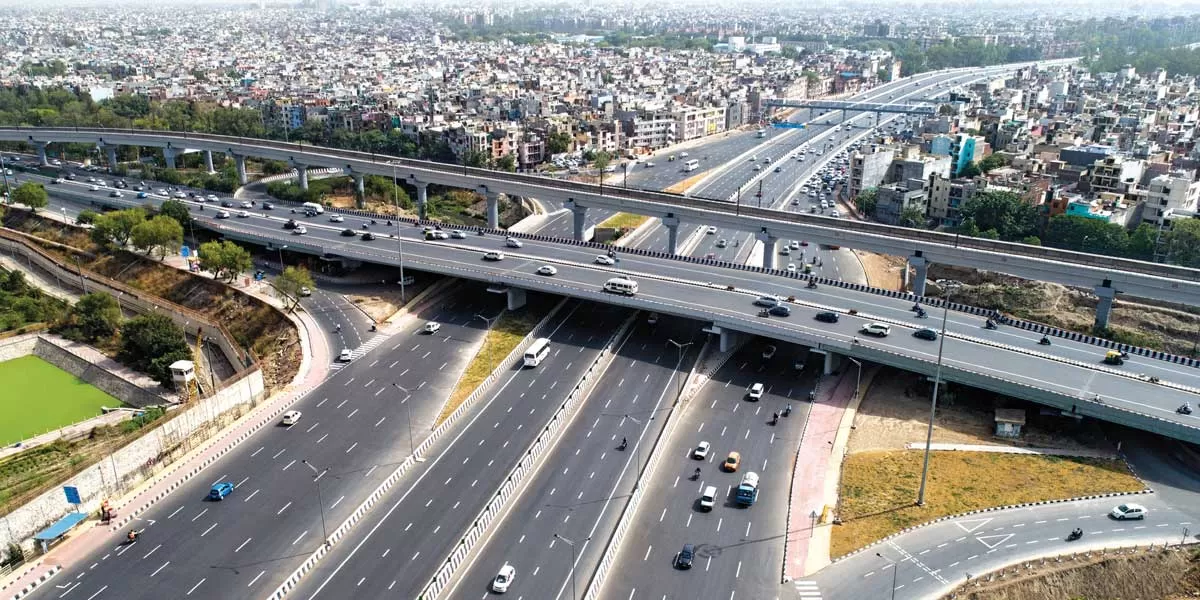Funds, policies, technologies and a winning attitude, this defines the Indian infrastructure financing sector today. The first assets created under this National Infrastructure Pipeline are now generating revenue, thus whipping up more investor interest. The bonds market has seen significant reforms. The government remains the largest driver, but the private sector funds are not far behind. This sector has passion, drama, excellence and the winning attitude todayFinancing Indian infrastructure is the world’s interest today. From pension funds in Canada to provident funds across the world, all look at parking long-term funds in the Indian system. As more funding becomes available, so does expertise. Or was it the other way round?Significant change happened in 2019 when the country drew up its National Infrastructure Pipeline. In saying this Padmanabhan Raja Jaishankar, Managing Director India Infrastructure Finance Company (IIFCL), articulated what most experts in the field have been saying. “The National Infrastructure Pipeline (NIP) is an unprecedented development because I don’t think any other country in the world can boast of this kind of system where at a centralised level you have a list of infrastructure projects being developed at different stages and in different sectors. So much information flow is happening at the NIP. This was followed by a National Monetisation Pipeline, a subset of the NIP, which gave the fillip to the possibility of asset churning. It is all about bringing back more capital. So, it will actually be a capital relief which is going to really help and generate more projects with the same level of fund flow.” That monetisation aspect is the key to the current level of infrastructure development. The need for long-term funds to finance the long-gestation projects was realised in 2006 itself when the IIFCL was established during the process of setting up the public private partnership (PPP) model. This kind of an entity was required because understanding and providing for long-term finance was essential those days. But the aspirations of each sector needed to be defined, its regulations fixed, risks assessed and sectors prioritised. Most importantly, the legacy problems needed to be addressed and fixed with policy interventions and meticulous regulation. Public finance needed to be allocated with stringent monitoring to be able to deliver the first round of reforms that would then bring back more capital into the system. In the words of Parminder Chopra, Chairman and Managing Director Power Finance Corporation, (PFC), a Maharatna public sector undertaking, which also holds majority stake in REC, “Policies need to be tailor-made and flexible to meet the needs of various sectors. In the 1980s and 1990s, India’s power deficit was consistently in the range of 15-20 per cent. It was then that PFC was set up as a dedicated institution to cater to the financing needs of the power sector. We understood the sector like no other, which enabled us to play a developmental role in the sector, in addition to that of a long-term financier for the power sector. During the subsequent decades, we facilitated a tenfold growth in installed capacity, partnered the Government in implementation of various sectoral reforms and witnessed the country turning power surplus, bringing the sector to where it is today.”As a result, today an array of finance options has been created. Long-term funds needed to be sourced and supplied differently by different organisations. Some to fund the green aspirations of a rapidly growing India, others to take the risk off the primary lenders, the banks, whose short-term capital was financing long-term projects. Yet others were to concentrate on sectors which needed not just funds but policies set right to pull them out of the poor financial and operational levels they were functioning at. More than anything the country needed to spell out its aspirations which would reflect the aspirations of the nation and provide funds required to finance the infrastructure required.Explains Jaishankar, “We needed to source long-term funds and we had to supply long-term funds. That was the essential purpose with which this entity was set up. Multilateral organisations became the major source of funding such initiatives. IIFCL's first line of assistance was to fund infrastructure projects which were greenfield. This majorly happened in the roads sector, followed by the power sector. It was only after the first decade of the new millennium that other sectors also started following this model. And gradually it got to other sectors as well, with airports, ports and various other new sectors coming into play. So now it is more or less an order of private investments which needs to actually complement the public investment to set the sector going. GDP Aspiration: The starting point of this infrastructure turnaround was a robust Gross Domestic Product (GDP) aspiration of a government that reflected the aspirations of the people. Today every head of an infrastructure finance organisation that I spoke to, clarified that the nation’s aspiration had to reflect the citizens’ aspiration. The words of Vivek Dewangan, Chairman and Managing Director REC, typify the attitude of infrastructure lenders: “Policies are driven by the expectation of the consumer. We have to meet the aspirations of the people.” Lenders also spoke of low or zero non-performing assets, operational efficiency of the project and therefore the capital. Meticulous self-evolved assessment processes are now being evolved. The infrastructure financing companies are today a mix of public, private and hybrid funds sourced domestically and globally. Tenures have grown and so have returns on investment. “Financial products are evolving in accordance with the requirements of various infrastructure sectors. Effective monitoring is also a critical element involved in utilising this capital well towards nation building through infrastructure development”, says Chopra of PFC.Shiva Rajaraman, Chief Executive Officer NIIF Infrastructure Finance (NIIF IFL), the infrastructure debt fund (IDF) which finances private sector and PPP projects, gives his take on the size of the infrastructure financing market and how it has and needs to attract both debt and equity capital. The starting point is India’s GDP of around $ 3.8 trillion. Adjusted for an infrastructure spend of 6 per cent, PPP and private sector segment of 25 per cent, proportion of debt of 70 per cent, rupee component of debt of 80 per cent, the size of the rupee-based infrastructure lending market for PPP/private sector projects in FY 2024 is estimated at around $ 32 billion.Out of this, we expect banks/ NBFCs to finance $ 20 billion in FY 2024. The balance $ 12 billion would need to be raised from other sources including pension/ provident/insurance/ wealth/ sovereign funds, private credit, HNIs, endowment/ impact funds etc.Increasingly, equity infusion has been, and is expected from pension funds (including Canadian) and private equity platforms, apart from Indian family developer groups. The above is expected through different instruments with varying long tenors including plain vanilla non-convertible debentures (NCDs), zero coupon bonds (ZCBs), mezzanine instruments, loans, Green/ Sustainable bonds etc.In this process a category of investment advisory arms of financial majors, such as SBI Caps, evolved to guide the fledgling sector. Explains a senior executive, “We advise on the uses of funds and sources, structuring and guiding them. The choices have to be based on projects and clarity. We try to find strategic partners and financial investments etc.” Today these investment advisors extend support in external equity capital, plain vanilla, mergers and acquisitions (M&A), start-up finances etc. There are no sectoral limits or restrictions. The advice is for working capital or refinance. The sectors are infrastructure and other projects such as oil & gas, roads, commercial real estate, cement and steel etc.So where are we in the cycle of reforms?Learning curve: Starting at the bottom in 2006, this all-inclusive portfolio has benefitted from the learning curve with a lot of on-the-job learning, particularly in the roads, airports and power sectors. Explains Jaishankar, “We had a lot of hiccups and some issues and challenges as well because of the first-time execution, we needed to understand a lot of things very well - for example, land acquisition. Then approvals, dispute resolutions, safeguards and credit enhancements. After 2014, many of these experiments have stabilised and we now have single window approvals for many of the sectors. We have faster resolutions. The arbitration mechanism has become much faster, we now have the Insolvency and Bankruptcy Code, we have the National Company Law Tribunal (NCLT), and have also put the SARFAESI Act in place.” This allows banks and financial institutions to recover assets if the borrower is not able to pay back the borrowed amount. This activity from the government and private sector, has pushed investors to be very active. Even in the long term, investors have been showing a lot of interest because of the promise that the sector holds. Operational advancement based on a strong learning from operational executions have been complemented with financial sector reforms. One of the biggest financial reforms was enhancing credit access to different kinds of funds in India and abroad. New age instruments include Infrastructure Investment Trusts (InvITs), Infrastructure Development Funds (IDFs), masala bonds and a number of other credit enhancement mechanisms. The bond market has been very active now. Rajaraman of NIIF IFL explains the changes relating to the bonds market. “The development of the bond market in the context of infrastructure, has been slower than expected, but positive. NIIF IFL borrows only through the issuance of bonds and therefore this market is very important for us. The quality i.e. credit rating of bonds issued and the quality of issuers, both have improved significantly in the last few years. So, the average quality of issuances is now A+, as against BBB four to five years ago, based on publicly available data from rating agencies like CRISIL. The tenor of bonds has also improved. Earlier you had very short tenor issuances. Now, because of demand for long term bonds from pension, provident and insurance funds, there have been significant higher quality issuances with tenors ranging from 5 to10 years. Liquidity/ trading is also a critical parameter which determines the extent of development of the bond markets. Trading has seen some improvement because of various initiatives by regulators. For example, SEBI mandated that a certain percentage of all funds raised by specified category of corporates, has to be through the issuance of bonds.”This new phase of growth of bonds, debt markets and more investors has really started because of the returns that have started coming in now. Jaishankar attributes this to the fact that assets that were started in 2006 have started yielding results now. By 2018 to 2020 assets being created in the early phase were completed. The completed assets started earning revenue and became an asset class of its own. So that has again evinced interest of investors. Jaishankar says almost 40 per cent of infrastructure assets are now completed and earning revenues. “Today Rs.29 trillion is the loan book of banks and the NBFC Infrastructure Finance Companies. Approximately `13 trillion is the potential new-age asset class which is up for churning. This `13 trillion can be a source of capital for doing more business without additional capital.”With infrastructure evolving as a very bright destination for investors, a number of investors already having had a feel of the market, big funds - provident funds, superannuation funds and insurance funds which have globally been seeking to invest in infrastructure projects, are making a beeline to India. “Airports have led the way to even greenfield investments,” says Rajaram. “These people have started investing in greenfield projects and other areas such as expansion of airports. The Foreign Institutional Investors (FIIs) have also started investing. The game is just beginning. And I see a great future and bright investment opportunity for many investors in infrastructure.”Risk definition and mitigation: For Jaishankar, “As far as infrastructure is concerned, the main risk is construction risk which comprises many component pieces - land acquisition, approvals, inter-ministerial and inter-departmental coordination. During the process of construction, one has to face a number of issues - legal and contractual issues, these are all the normal risks that an infrastructure project would face. And it depends on the sectors - to what extent they have been able to put in place the concessions, to have control over their systems and processes.”Explains the merchant banking professional “The major risk mitigation factor was creating 5, 10 and 15-year loans. This was a major uncertainty earlier and gave the banks more comfort. In many cases partners also brought debt. The debt risk was brought down by bringing equity. So, hybrid capital was the answer. The bank lending became about 20-25 per cent. About 25 per cent was the sweet spot that gives the lender more comfort. Private credit players have become more active in infrastructure credit. Risk assessment: Rajaraman says that NIIF IFL created a whole new proprietary system of risk assessment and management to manage the ten key heads of risks. “The broad heads under which we assess risk are - promoter risk, regulatory risk, market risk, financial risk, technology risk, financing risk, construction risk, operations risk, resource risk and security risk.“For example, market risk could consist of assessment of demand-supply, pricing, quality of off-takers (i.e. counterparty risk), quality of output etc. In projects that we finance, there is no construction risk as we are permitted to provide funding only at the operational stage.Resource risk in wind power projects, for example, would include assessment of wind availability, wind intensity and wind speeds, resource risk for solar power projects could include assessment of the extent of irradiation (i.e. receipt of sunlight on the surface of solar panels), resource risk for “run of the river” hydro power projects, could include assessment of rainfall availability. In the context of security risk, we look at availability of security, charge to lenders and enforceability.“In respect of promoter risk, we must be the only organisation in India that has a formal framework of grading promoter groups (example – G1, G2, G3 etc). Based on this grading, we decide how much we want to lend to the group. The Reserve Bank of India (RBI) permits a certain percentage of net worth that can be provided as loans to a single promoter group.We do not lend right upto the limit, to every group; rather we lend up to whatever our grading framework mandates us.“In the context of counterparty risk, we have a grading system to assess off-takers like discoms (power distribution entities owned by state governments). Our liquidity buffers (called debt service reserves) are sized based on this grading.“We provide non-recourse financing to “ring-fenced” projects. For example, if ABC group collapses (like IL&FS group collapsed a few years back), our project would remain unaffected because we depend principally on the cash flows of the project and not on undertakings, guarantees etc of payment by the promoter. Our financing is structured in such a manner that we are not dependent on the promoter group at all.”What does a promoter group bring to any infra project? For Rajaraman, “A promoter (i) acquires land, (ii) secures approvals, permissions etc from the government (iii) brings his share of equity into the project and (iv) gets the construction completed (v) undertakes operation and maintenance (O&M) of the project.”Since NIIF IFL comes in only into the operating stage of a project, risk factors (i), (ii), (iii) and (iv) are already mitigated. “The only point on which we are dependent on the promoter group, is in respect of O&M of the project. We have insulated our company from this risk also, by having a contractual right to replace the O&M operator with an O&M operator of our choice if certain parameters are not met, which we check on a periodic basis.”Apart from that, for example in solar power projects, “we are the only lender in India who gets solar modules tested under lab conditions to assess degradation over the next few years. The output of this lab report is what we use in our financial model for making long-term financial projections.”NIIF IFL has a graded system of liquidity buffers - this includes funds set aside in case of any eventuality so that there are no delays in payment of principal and interest to us from the borrower, in any unforeseen eventuality. “For example, during Covid, toll booths for road/highway projects were shut and there was no toll collection. We have a six-month debt service amount, set aside from project cash flows and kept in a separate fixed deposit or in a mutual fund, so that under such eventualities, we (as a lender) get our payment in time.We also have a surplus cash pooling mechanism. If a promoter has five different projects in five different states and we have funded more than one of them, we have a pooling mechanism so that in case there is a deficit in one project, the surplus of the other projects could be utilised to pay the debt service (i.e. principal + interest) of this account. It is a firm contractual arrangement and not an informal arrangement.”NIIF IFL also the only lender who has, in recent years, been connecting its software to that of the solar plant “so that we can get minute by minute updates, i.e., “real-time monitoring” in respect of generation and performance of the equipment. Normally lenders refer to audited statements which are obtained 3-6 months after the end of the quarter or year – this cannot be “early warning” as the data is received late. Our online assessment is intended to track projects and equipment on a minute-by-minute basis so as to provide us “early warning” signals of anything going wrong in the project.”“Fastag” data i.e., data on electronic toll collection for roads has really revolutionised monitoring aspect of project finance to the sector. Earlier there used to be a worry that some of the cash collected at tollbooths, may be syphoned out prior to deposit in the escrow account on which lenders have a charge. “After implementation of “Fastag”, on PPP projects in national highways, this risk is almost eliminated because the toll collection comes directly to the escrow account. NHAI proactively provides data on 'Fastag' toll collection, enabling lenders like us to monitor our projects more effectively.”Power sector: Power sector reforms have been one of the most significant in the Indian marketplace. With two highly competent public sector Maharatnas financing the reforms, it is on its way to becoming one of the very well managed infrastructure sectors. The excitement and enthusiasm is clear in both the Power Finance Corporation and the REC. This was imperative as currently India’s power consumption track record is just a third of the world average. As the problems get fixed and the country marches towards becoming a developed country in the next 25 years, power consumption will at least catch up to global averages. With regulators and lenders using the carrot and stick policy to enforce reforms, there has been significant improvement of processes and operations. Basic infrastructure access was the first step. Explains Vivek Dewangan, CMD, REC, “We were able to achieve universal access to electricity in record time; 100 per cent village electrification was achieved in 987 days against the target of 1,000 days given by the Prime Minister Narendra Modi. Thereafter we resolved the household electrification issues. We covered about 20.86 million households in 18 months. These are two major milestones. After universal access to electricity was achieved in 2018-19, now whatever policies are being framed by the Central or State Governments, are from the perspective of consumers.There is a history to this stand. With electricity in the concurrent list of the Constitution, both Central and State Governments have their roles to play with regard to policies in the electricity sector. As Dewangan says, “Having resolved the issue of universal access to electricity, the consumers started demanding 24x7 reliable, quality and affordable power.” Many reforms started after universal access to electricity, thanks to the Deen Dayal Gram Jyoti Yojana and the Saubhagya scheme. Now the Revamped Distribution Sector Scheme (RDSS) has been launched in July 2021 with an outlay of more than `3 trillion. “This is a path breaking initiative targeting to improve the operational and financial efficiency of the distribution companies and also to ensure 24x7 reliable power to the consumer.” PFC group, along with its subsidiary, REC, is designated by the Government of India as the nodal agency for implementation of RDSS and the Late Payment Surcharge Rules (LPS), two of the key ongoing reforms in the distribution sector. It is essentially a carrot and stick policy, where past unpaid dues were computed and converted to equated monthly instalments to be paid by the state entities. Explains Chopra of PFC, which also has a stake in REC, “Under RDSS, out of the total sanctioned loss reduction projects worth Rs.1.4 trillion tenders for 88 per cent have been floated and 70 per cent of the works are awarded. Remarkable progress has been made in smart metering, with about 200 million smart meters sanctioned and tenders for installation of about 90 million smart meters awarded. The impact of the scheme is evident from the consistent improvement at an all-India level of AT&C losses over the past two years - 16.42 per cent in FY 22 and 15.85 per cent in FY 23 (provisional) – compared to 21.5 per cent losses in FY 21. Explains Chopra of PFC, “Other performance parameters like cash-adjusted revenue gap, receivable days, payment days etc. have also registered marked improvement from the levels seen two years ago. Significant improvement is also seen in the compliance culture of discoms, in the form of timely filing and issuance of tariff orders and submission of quarterly and annual accounts. Equally noteworthy is the success of LPS Rules. The legacy dues payable by distribution utilities have come down to Rs. 580 billion, down 58 per cent from their peak level of Rs.1.4 trillion. Current dues are also being monitored rigorously with the help of PRAAPTI portal, which is set up and maintained by our subsidiary, PFCCL. Power regulation is resorted to, for discoms where outstanding dues are not paid by the trigger date. This has brought in much needed fiscal discipline in the sector, which is helping all the players across the power sector value chain.”Dewangan, whose REC Ltd. became the 12th Maharatna company in India in 2022, says “Major bottlenecks of the distribution sector was affected by certain issues - they had legacy dues from the Government Departments of Rs.1.35 trillion, they had legacy subsidy, State Governments keep announcing subsidies to certain targeted populations but they failed to pay that amount to the distribution companies in lieu of the electricity they are giving free of cost to certain classes of consumers. Regulatory issues were there - the State Electricity Regulatory Commissions tariff petitions were not being filed in time. They were not able to issue the tariff order in time, the tariff was not truly cost-effective, leading to high AT&C losses and gap in ACS and Average Revenue Realised (ARR). RDSS has addressed all these issues. “Distribution companies have committed to a certain trajectory for bringing down AT&C losses, which have been supported by the State Government Cabinet resolution. State governments have committed to bring down state government department dues, to clear the legacy subsidies and they have started paying the current subsidies in advance. For Q3, they have already paid the advance subsidy in Q2. The tariff petitions are being filed in time. Tariff orders are being issued in time and now the Ministry of Power has impressed upon the State Electricity Regulatory Commissions that tariff should be truly cost reflective. If the cost of power being produced by state utilities are `4-5 per unit, they should be able to recover it because they have to pay their O&M cost, salary payment of their staff, etc. In this direction, State Governments are committed to this trajectory. Now we can see the improvement. Government department dues have come down from Rs.1.35 trillion to Rs.630 billion, subsidy dues have come down from Rs.1.30 trillion to Rs.600 billion. They have committed that this will be paid in the next 3-4 years. By 2025-26 it will all get cleared. State governments have actually started paying current subsidies in advance. All these have led to reducing AT&C losses which have come down by 5 per cent, from 22 per cent to 17 per cent in one year. RDSS is aiming to bring down AT&C losses to below 15 per cent. And some of the states are targeting to bring AT&C losses to single digits, below 10 per cent.” Having addressed the legacy issues at the state level, user pay charges are also being addressed. Pre-paid smart meters are expected to play a very crucial role in improving the collection and billing efficiency of distribution companies. With Late Payment Surcharge (LPS) reforms by the Ministry of Power, the virtuous cycle has been kick-started. When distribution companies paid the dues of Gencos and Trancos in time, their LPS of 12-15 per cent was waived off. They have been asked to clear their dues in a maximum of four years in 48 equated monthly instalments. Most of the Discoms have opted to clear the dues even earlier - some of them have already started clearing the dues, most will clear the dues in 2-3 years. Explains Dewangan, “LPS rules have brought in liquidity. They have borrowed from REC /PFC and paid to distribution companies and the distribution companies have started paying Gencos and Transcos. Health of Gencos and Transcos has also improved and distribution companies have also got payment from government departments. So, the major pain of the distribution sector is being addressed. Right now, the liquidity situation is improving. Renewable power: Supplementing this is the massive thrust in India towards renewable power resources and sustainable growth. Chopra of PFC estimates the resources required. “According to various estimates, the total funds required to finance India’s Net Zero Transition by 2070 ranges from $10 trillion to $20 trillion – around 80 per cent of which is in the power sector, around15 per cent in the industrial sector and the balance in mobility. In the Indian context, about 60 per cent of the fund requirement would come from domestic sources and the remaining has to be mobilised from international markets – through bond markets and MDBs, green funds etc. So, we are looking at a figure of not less than $4 trillion from the International Financial Institutions.”NIIF IFL lends only to the private sector and PPP projects, provided they are financially, operationally and environmentally sustainable. Explains Rajaraman, “Green hydrogen projects are still some time away - it could take a few years. In terms of generation, there is a huge market for solar and wind energy. This is expected to be accompanied by storage projects. Pumped hydro storage is a relatively new prospect and a cost-effective method of storing electricity.If you are going to get so much generation, you also need transmission networks to keep pace. Transmission projects are extremely safe. Once they are constructed, it is almost like an annuity project and there is not much difficulty in maintenance. Power Grid Corporation, being the nodal agency of the Government of India, is a very good counterparty in terms of credit rating and payment track record.”For Chopra of PFC, the largest lender in the power sector, with about 20 per cent market share and an outstanding loan book to power sector at Rs.4.4 trillion, supporting about 230 GW i.e. over 50 per cent of the country’s installed capacity, the future looks bright. “In the past decade, we have consciously adapted our business model to increase the renewable energy business, by integrating climate risk into our appraisal, lending and pricing strategies. As a result, our RE assets have grown at a CAGR of over 30 per cent during the period and today we have the largest RE loan book in the country amounting to Rs.520 billion. Till date we have funded RE projects of over 54 GW with cumulative sanctioned loans of about Rs.2 trillion and cumulative disbursement of around Rs.1 trillion.”In this direction, PFC has partnered with multilateral agencies and foreign developmental institutions to secure low-cost funding for projects that contribute to India’s net zero objective. A significant milestone in this effort is the partnership with Japan Bank for International Cooperation (JBIC), under its initiative titled Global Action for Reconciling Economic growth and Environmental Preservation initiative. The funds under the facility would be used by PFC to finance its renewable energy portfolio.PFC is also the first company from India to join the Asia Transition Finance Study Group (ATFSG), an initiative led by the Japanese Ministry of Economy, Trade and Industry (METI), for promoting sustainable transition finance in Asian countries. But emerging technologies are going to be opportunities as well as a challenge. There are multiple options and different challenges to be met. Dewangan of REC says, “In renewable energy, the major risk is technological advancement. Renewable energy is intermittent so we need storage solutions for round-the-clock power supply. Customised solutions are battery related storage. Again, we are going to be dependent on imports because we don’t have resources of lithium ion. Pump storage hydel solutions are the best for India but there are associated risks of resettlement and rehabilitation in hydel projects and cost is also on the higher side. The third solution is the hydrogen fuel cell where a lot of research is already taking place. The other niche area is green hydrogen, green ammonia - it is very difficult to transport and store green hydrogen. To transport and store, it would be better to convert it into green ammonia. There is a huge demand for green ammonia. But the cost of generation of green hydrogen is about US$ 5-6 per kg as of now. Until and unless the cost comes down to US$1 per kg, it will not be viable commercially in the long term. We need to develop electrolyser technology to bring the cost down of green hydrogen and green ammonia.”Suggestions: There are various suggestions put forward by the government or third parties. Jaishankar of IIFCL says: “The infrastructure sector needs to be looked at holistically and an infrastructure law must be established to address the concerns and priorities of all stakeholders. There is a need to expand the bipartite structure of concession agreements into a tripartite one, involving the lenders. This expansion would introduce several beneficial practices, such as conducting ratings prior to granting concessions. At the concession authority level, it is necessary to bifurcate the termination payment system and transfer it to the domain of insurers. This could facilitate the adoption of the new product by insurance firms and also instil confidence among investors and lenders. Further it is necessary to have measures to encourage institutions such as Employees Provident Fund Organisation (EPFO) to participate in infrastructure financing. After the IL&FS crisis they had almost stopped coming. If such institutions could be mandated to invest in at least the better corporates, it could trigger buying and selling of bonds. Also, there is a need to introduce a category of market makers. An institution that provides buy and sell both to help improve tradability of bonds. Rajaraman takes heart from the fact that many of the policy and regulatory changes relating to Infrastructure Debt Funds (IDFs) were addressed in the August 8 speech of the RBI governor. “Infra debt funds were earlier permitted to fund only BOT road/ highway projects.Now other categories of road/ highway projects have been permitted for financing, including TOT etc. That is a clear positive. Earlier we could not raise External Commercial Borrowings (ECB ) loans from foreign institutions. Now RBI has permitted it. Today we can raise funds through green/ sustainability bonds or loans from IFC (an arm of the World bank), ADB, FMO or any other institution which was not allowed earlier. Additionally, more IDFs could be set up, provided they conform to certain regulations and secure RBI permissions”Clearly, India’s infrastructure growth is no flash in the pan. It has been meticulously planned, keeping in mind the aspirations of the country and its citizens. Facilitating finance, removing past bottlenecks, securing global investor interest and still adhering to India’s lofty green and sustainable goals and ambitions, this sector has set global investor interest on fire. It is expected to continue for at least the next couple of decades. Long-term finance, technologies and policies are being facilitated. However, the funds are available only to those who toe the financial literacy and management line. The urban municipalities sector, despite its potential, will be hard-pressed to source these funds unless they can improve their ratings. For those who value performance, it is a case of winners all. - E Jayashree Kurup




















